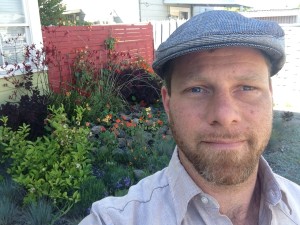Here in Northern California, we are blessed with many stoic and picturesque native oaks. Quercus agrifolia =Coastal Live Oak, Quercus lobata = Valley Oak, or Quercus douglasii= Blue Oak are all found in this bioregion. Many people are talking about Sudden Oak Death and other oak ailments as a result of anthropogenic (manmade) influences. Fear not, by following some simple rules and planting specially adapted native plants, you can foster life under your oaks.
Our California oaks have evolved to have dry roots for the summer months. One of the main mistakes I see in consulting with homeowners and ranches, is that irrigation is installed too close to the drip line of the oak. This “wet feet” easily can lead to rot and disease. By choosing the right specialists for the very specific habitat of Oak understory, you can achieve a full, vibrant understory that will bring hummingbirds and other wildlife right underneath the majestic oaks and into your window’s views.
Drip Line Denotes Microclimate
The drip line is where the edge of the branches make a circle that defines where the majority of rain drips out to the edge of the tree. In intact nature, you will see in the Oak Savannah where a diversity of plants are growing “at the skirt of the tree” due to the increased moisture of this drip-line perimeter. These plants receive the benefits of more rain, running off the oak as well as more light than inside the canopy. This makes the drip line a sweet spot for many Oak Savannah natives.
Try these native plants on the drip line’s edge:
*Salvia spathacea = Hummingbird Sage,
*Salvia sonomensis = Sonoma Sage,
*Achillea millefolium = Yarrow
*Festuca californica = California Fescue.
Likewise, if there is vacant space in the part shade of the oak, yet outside the drip line, then the list of edible plants below will do fine for you here in the Bay Area. As it is outside the drip line, it is safe to water twice per week.
Edibles for Oak Shade *(Outside drip line)
-High Bush Blueberry *(Vaccinium corymbosum) “Sunshine Blue” and “Jewel”,
(*Low Chill) Cherry: *(Prunus avium)“Royal Lee”
Note: Cherries like acid soil and in the low chill of the Bay Area, some shade can actually be a positive.
(*Low Chill) Apple: “Fuji” and “Pink Lady”
Note: Like Cherry, Apples don’t mind light shade to trick them into thinking our winters are more pronounced than in full sun.
Currants
Edible Cultivars of Currant do well in the light shade outside the canopy. As the food cultivars of Red Currant and White *(ribes rubrum), White Currant and Black Currant *(ribes nigrum) need more water than the native cousins, they need be separated for the benefit of the Oak above. Under these perennial food crops, you can grow Rhubarb *(Rheum rhabarbarum).
Raspberry *(rubus idaeus): Raspberry will tolerate the light shade.
Dry Oak Shade Specialists (Inside the drip line)
Inside the drip line is another story. Inside the dark canopy of oaks is the realm of native plant oak specialists. These plants have adapted over eons to tolerate the shade of the oak as well as the intense acidity of the oak leaf duff. Additionally, these plants have taken growth habits that are vertically upright. This allows for them to stay above the leaf drop in autumn when the leaves can accumulate over a foot deep! Note: Do your part and do not irrigate directly under your oak canopy, not near the trunk/root crown.
Try these native plants for within the oaks canopy:
Iris *(Iris douglasiana),
Oregon Grape *(Mahonia repens),
California Barberry *(Mahonia pinnata),
Pink Flowering Curant *(Ribes sangueneum) ,
Golden Currant *(Ribes Auereum),
-Fuschia-Flowered Gooseberry *(Ribes Speciosum).
Note: All these native plants listed for under the oak canopy are drought tolerant. To establish these plants, only water 1 time per week. Drip irrigation is the preferred delivery method, as it will target the new plants root zone without soaking the surface or overwatering. If the soil is workable, these plants can be planted in the wet season.
Joshua Burman Thayer is a landscape designer specializing in drought-tolerant and edible plants. He has designed over 50 Edible Estates around the Bay Area and is engaged to Chelsea Bearce, a Benicia native. Thayer can be found at his website NativeSunGardens.com. You can also follow him on Twitter at @nativesungarden.







Thank you for this article. As a member of the Willis L Jepson Chapter of the Ca Native Plant Society, I would also like to suggest Alum Root (huecheria) as another plant who ch grows well here in Benicia and would do well under Coast Live Oak. Additionally the Jepson Chapter will be having its spring plant sale on the patio of Heritage Presbyterian Church the first Saturday in May. Come by and see what plants we are growing in our nursery ourselves in as pathogen free manner as possible. These plants are appropriate to be planted in the spring time and we will help you understand how to plant them successfully. Come support your local chapter of the Native Plant Society!